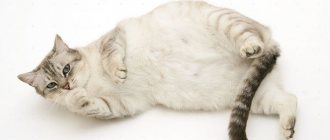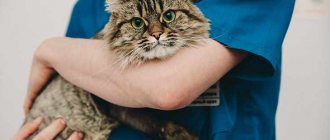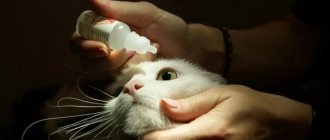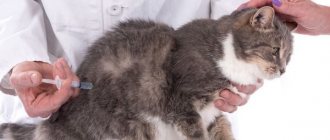Welcome, dear readers, to the cat care blog!
Information on how to cure a particular disease is a purely medical thing, but in what cases to seek help from doctors is useful for us to know!
And although today the reason for communication is very serious, as you will see for yourself, in the end everything will be fine, believe me, if the matter is not taken too far!
So what should you do if your cat has yellow discharge? But they are not only yellow!
Let's take a look at all the reasons for such phenomena, shall we? Caring and attentive owners need to be aware of what is happening in the animal’s body. Do you agree?
Diseases of the reproductive organs
Mucous, cloudy, brown discharge is a sign of glandular cystic endometrial hyperplasia (GCGE). The pathology is caused by hypersecretion of the uterine glands, obstruction of the excretory ducts, and the presence of cysts.
When examining the animal, the following is revealed:
- vulva enlargement
- poor condition of the female
- lethargy, apathy
- lack of appetite
- drinking a lot of water
- dull coat
- enlargement and density of the uterine horns
Mucopurulent excretion can be observed in the purulent form of vulvitis and vaginitis, as a result of penetration of pathogenic bacteria and fungi into the tissues of the vulva and vagina.
Bloody, pus-like discharge from the vagina is a sign of acute endometritis, which, if left untreated, can develop into a more serious form - pyometra.
Pus from the loop is an alarming symptom indicating an inflammatory process in the uterine cavity (open form of pyometra), which can result in the death of the pet. The secreted contents have a yellowish-green or brown tint. Sometimes the discharge becomes heavy and then stops for several days.
Condition of the female:
- general weakness, immobility
- decreased appetite and body weight
- thirst
- nausea, vomiting
- frequent urination
- temperature over 40˚С
- the stomach is enlarged and tense
Contents from the genital slit of a whitish, yellow-green, dark brown hue indicate the presence of a chronic form of endometritis, which developed as a severe consequence of GCGE as a result of the penetration of bacteria from the external genital tract into the uterus.
The general condition of the female is unchanged, but with a complicated course, depression, refusal to feed, increased water consumption, and frequent urination are observed.
Vaginal discharge can occur during prolonged estrus, which is also a pathology and requires examination by a specialist.
Preventing discharge in cats
It should be noted that it is not the discharge itself that is prevented, but the appearance of pathologies that are accompanied by this symptom.
- Do not overuse hormonal medications that interrupt or delay the onset of estrus. This is especially true when it comes to compliance with the dosage and frequency of administration.
- You should always follow the rules of antisepsis at the time of birth if there is a need for obstetric assistance.
- You should definitely do an ultrasound on a non-parous and non-sterilized cat at least once a year (ideally every six months) and spayed from time to time.
- Choose only a healthy cat with vaccinations for mating.
- At the slightest suspicion of discharge of any nature that does not correspond to the physiological state, a visit to the veterinary clinic is mandatory.
Author:
Grinchuk Ekaterina Andreevna veterinarian
Pathologies during pregnancy and childbirth
Bloody black/green discharge during childbirth without any signs of labor is a life-threatening condition for the female.
Possible reasons:
- primary uterine laxity in combination with the death of at least one embryo and separation of the placenta
- death of embryos in the middle or late stages of pregnancy and their blood mummification
Postpartum discharge from the loop (lochia) is normal, but monitoring it is extremely important. Excretion continues from 7 to 30 days, gradually changing color to lighter and decreasing in volume.
In the absence of complications, at first the lochia have a greenish color (the first day), then they become light pink. If they are odorless and not accompanied by high fever, indigestion and other painful symptoms, then there is no reason to worry.
Bloody discharge, or a change in the color of lochia (dirty green, brown) with an unpleasant odor, accompanied by tension in the abdominal wall, symptoms of intoxication, and high temperature should be a reason for an urgent call to a veterinary gynecologist.
Foul-smelling red purulent clots after childbirth are signs of postpartum metritis, which developed as a result of bacteria entering the uterus during childbirth, auxiliary manipulations, retained fetal membranes, and miscarriage.
The female shows signs of intoxication, she is depressed and refuses to eat. Body temperature is high, as evidenced by a hot, dry nose and heavy breathing.
As a result of cessation of lactation, babies cry from hunger and cold. Possible maternal death.
Cats Pyometra (Purulent inflammation of the uterus) Vetna
Cats, just like people, unfortunately suffer from various diseases.
One of the dangerous diseases in our pets is pyometra. It is cats, not cats, who suffer from this disease, because pyometra is an inflammation of the walls of the uterus, in which pus accumulates in the uterus itself and its horns. This disease is very dangerous because if you do not take action in time and do not take the cat to the veterinarian, there can be so much pus in the uterus that the uterus simply cannot stand it and bursts and all the pus spills into the abdominal cavity and then, unfortunately, there is a high probability that your pet will die in no time. There are several reasons why your cat may get pyometra: - if you decide to breed her with a cat to produce offspring and have not checked whether this cat is healthy or not. To reduce the risk, it is better to check the cat, because he may have some sexually transmitted diseases; — if you decide to give your cat various hormonal drugs, thanks to which your cat will not scream during estrus. These drugs will certainly make your life easier, but they can also be dangerous; it is better not to use them. However, if you still decide to give your cat such drugs, consult with your veterinarian which drugs are suitable for your pet; - if the cat has some kind of hormonal imbalance, its body is weakened, and neoplasms (cysts) have appeared in the uterus. These are the main causes of pyometra in cats. It is also known that this disease more often appears in old and middle-aged cats. However, young individuals can also get sick. What are the symptoms of this disease you ask. After all, you won’t be taking your cat to the veterinary clinic very often. This is a lot of stress for the animal, and the examination also costs money, because pyometra is best seen on an ultrasound. Symptoms of pyometra in a cat: - large, swollen belly. You may think that your pet is pregnant; - the cat has ceased to show interest in food; - the animal is hot. Although cats naturally have a higher temperature than humans, you can determine whether its temperature has increased or not simply by touching its ears and nose. If they are hotter than always and the cat is not lying in the sun or radiator at that moment, then most likely she has an elevated temperature, which means she has inflammation; - Your pet has suddenly become lethargic, does not react to anything, does not want to play; — Have you noticed that the cat often licks itself under its tail? Sometimes this happens so often that even bald spots form there. It is also possible that purulent discharge may appear, although this is not necessary. - Your pet has developed an unnatural thirst that is not inherent to her. The cat drinks water very often and pees often. If you notice several of these symptoms in your cat, immediately take her to the veterinary clinic, because the sooner treatment begins, the greater the chance that the cat will recover. There are two ways to cure pyometra: medication and surgery. However, please note that only a veterinarian, after a thorough examination of your pet, can prescribe treatment. Never self-medicate, you can make things worse for your cat. Trust the veterinarians, they will conduct urine and blood tests, look at the cat for an ultrasound, and only then will they be able to correctly prescribe treatment. Most often, in the case of pyometra, veterinarians suggest surgery to remove the uterus and horns. Usually such operations are successful, and the cats survive and recover. The most unpleasant thing about the operation is general anesthesia. Unfortunately, there is a small chance that the kitty may not wake up after it. However, these are rare cases. Also keep in mind that after the operation your pet will never have offspring again. There is another way of treatment - with the help of medications. Of course, in this case, after treatment, the cat will be able to produce offspring, since its uterus will be in place. However, this method may not be particularly effective, and relapses are possible. Which method to choose is of course up to you and your veterinarian, but there is a high probability that you will have to choose surgery. And some more food for thought: if you never intend to breed your cat, veterinarians recommend spaying her at a young age before her first heat to avoid the possibility of her developing pyometra.
Why does my cat have white discharge? Will they go away on their own or do I need a veterinarian?
A liquid substance sometimes appears on the external genitalia of cats. The type of these secretions indicates the reasons why they are formed:
- watery;
- transparent;
- cloudy;
- purulent;
- mixed with blood.
First, we will talk about cases where the discharge is normal and physiological.
- Alexey Shevchuk
therapist, neurologist
certificates reviews
- Aigul Sopova
therapist, surgeon
certificates reviews
veterinarians at the clinic
- Estrus. In this case, the discharge is transparent, without an unpleasant odor. Of course, you won’t confuse estrus with anything, because the cat characteristically arches its back and behaves restlessly.
- Pregnancy. Until the third week of pregnancy, clear, thick mucus may appear along with the urine. This is nothing more than a mucus plug that forms in the body of a pregnant female. Until the sixth week, clear fluid appears - excess amniotic fluid.
But the following options are associated with pathological processes.
- White discharge in a cat may be associated with vaginitis. This is an inflammatory process in the vagina. It can occur due to an attack of streptococcal infection, staphylococcus or E. coli.
- Endometriosis is an inflammatory disease in the uterus. At first, the discharge is light and clear, but can soon become copious, thick and foul-smelling.
- Bloody marks under the tail of a pregnant cat indicate that a miscarriage may occur. And in the postpartum period, this phenomenon is due to the fact that the placenta has not completely come out.
- When a cat goes to the toilet with white discharge, and other signs appear - a bloated abdomen, frequent urination, then pyometra can be suspected.
- Pyometra, a common inflammatory disease in cats aged 3 to 8 years, is an accumulation of pus in the uterus. Doctors distinguish open and closed forms of this disease.
| Open | The cervix is open. A purulent substance is released outside. |
| Closed | Pus does not leave the uterus, but accumulates in it. There is no discharge from the genitals. |
The closed form is considered very dangerous, since in its advanced form it leads to inflammation of the uterus, peritonitis and, ultimately, death.
- Pyometra often becomes a complication after untreated chronic endometriosis. It is also fraught with infertility, sepsis, and peritonitis.
Veterinarians often observe white discharge from a cat’s loop (that is, from the genital area) after taking hormonal medications. It is no coincidence that veterinarians recommend promptly sterilizing domestic cats. This will not only save them from estrus and other unpleasant manifestations of sexual desire, but will also serve as the prevention of many diseases. If owners, instead of surgery, give their pet hormonal antisex pills, then sooner or later they will cause irreparable harm to the cat’s health, leading to benign or malignant tumors and inflammatory processes.
Video: Cat discharge
Prevention
In order for the process of bearing offspring in your animal to go smoothly, it is important to carry out preventive measures in a timely manner. Moreover, it is better to carry out some of them not at the moment when mating occurs, but throughout the entire life of the animal.
Monitor the animal’s health, get all the necessary vaccinations on time and select the right food, taking into account all the parameters. It would also be a good idea to have periodic checkups with a veterinarian.
After mating, you should carefully monitor the condition of the animal and pay attention to even the smallest changes.
- All the veterinarian's instructions must be followed very carefully.
- During pregnancy, you should protect your pet from cold, drafts and dampness.
- For mating, you should choose a healthy partner who has all the necessary vaccinations.
It is important that mucous discharge can also appear in a sterilized cat a short time after surgery. They have a slimy consistency and yellow color, but do not have a strong odor. If such discharge does not stop for a long time, then you should show your pet to a veterinarian, as inflammatory processes are likely to develop.
Proper care and following all doctor’s recommendations will help your cat have a normal pregnancy and give birth to healthy kittens. It is important for the owner only to pay attention to the condition of the pet, and everything else will happen by itself.
This article has been checked and approved by a veterinarian. Knyazeva Anna Vladimirovna, veterinarian in private practice, Moscow. more about the expert.
(you can vote for the article)
Tags: cat pregnancy, cat discharge, cat
- Related Posts
- The cat's eyes turn sour: what to do?
- A cat eats kittens - why?
- How to quickly remove fleas from a domestic cat?
Causes of cystitis
Cystitis can be caused by:
- damage to the mucous membrane by salt crystals or larger stones (stones) in urolithiasis in cats;
- changes in the bladder wall due to tumor or injury;
- penetration of pathogenic bacteria and viruses;
- unbalanced feeding;
- insufficient water consumption;
- intoxication;
- Without obvious reasons - idiopathic cystitis.
It is important to establish the cause of the disease - treatment tactics depend on it.
The most common is idiopathic cystitis, this is due to the peculiarities of water metabolism in cats. Very often, cystitis is observed in conjunction with urolithiasis; it is reliably difficult to say what was the root cause - bacteria in the bladder that cause inflammation can serve as centers of crystallization and thus contribute to the formation of stones, and crystals and stones, in turn, can injure the walls of the bladder and provoke the development of cystitis.
Separately, it is necessary to say about feeding habits that can provoke the development of cystitis. Contrary to popular belief, dry food does not lead to cystitis and urolithiasis in cats. But it does have an indirect effect - some cats on diets with dry food do not drink enough water due to the peculiarities of their water metabolism. As a result, the urine is very highly concentrated, dense, and such urine serves as a very good environment both for the development of bacteria and for the precipitation of salts, which can turn into uroliths. This problem can be prevented by monitoring your cat's water intake. To understand whether your cat drinks enough water, you can take a general clinical urine test - if the density is high, then there should be more water. You can also observe the condition of the urine - dark, cloudy, with a pungent odor almost certainly requires dilution; the urine should be light and transparent. To increase water consumption, you can try several options - place bowls in different rooms of the house, use not only ordinary bowls, but also drinking fountains - some cats ignore standing water, but happily drink current water. You can add a few drops (for flavor) of milk or broth to the water, but such water must be changed frequently. Another way is to replace dry food with wet food, or have a nutritionist calculate your home diet.
An unbalanced home diet can also cause the development of cystitis in cats.
What is the reason for discharge from the snare of a sterilized dog?
This happens extremely rarely, but there are still several possible reasons:
- during sterilization, part of the ovary remains, and the animal continues to go into estrus, and, accordingly, periodic discharge;
- cultitis - inflammation of the stump of the remaining uterus after its removal;
- vaginitis - inflammation of the vaginal walls; during sterilization, the ovaries, body and horns of the uterus are removed, the vagina is preserved, and accordingly, inflammation may occur;
- neoplasms in the vagina.
The exact cause can be determined by visiting a specialist who will prescribe specific therapy or conduct additional necessary research.
As a rule, no complications occur after sterilization, and most veterinarians recommend routine ovariohysterectomy for females and castration for males - these operations prolong the life of your pets and allow you to avoid a huge number of diseases associated with the reproductive system.
We all know that it is better to prevent any disease in time than to treat it. If any of these symptoms occur, we recommend contacting your veterinarian immediately.











